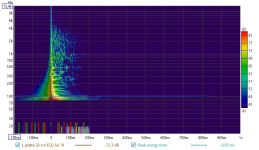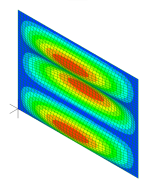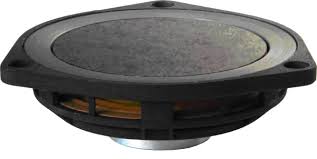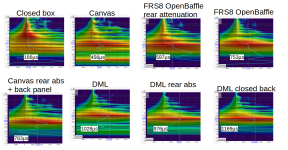Lekha,Someone is using Aiyima "exciters" and simple XPS panels, simply standing and resting against the edge of the table.
You can compare
Can you please share some of your designs.
Thomas
A Russian perspective on exciters, panels, and related topics, featuring a 5-year-old video. Use English subtitles. Best watch to the last minute. 🙂
Don't hold your breath, Thomas.Lekha,
Can you please share some of your designs.
Thomas
Eric
Christian,My current difficulty is a peak around 500Hz remained what ever the back load is, even a closed one. It is in the measurements of the DML and the FRS8 in open baffle even when the back is closed suggesting the source is not the rear wave.
Before looking an "exotic" explanation, are you sure that the 500 Hz peak is not simply natural frequency of the panel? That would be the most likely source. Have you done an impedance test to look for an impedance peak at the same frequency?
In the spectrogram shared by Thomas (below), there appears to be a panel resonance at the same frequency, about 480 Hz, as the peak in his SPL curve without DSP. His panel is pretty well damped (with EPDM I expect) but there are still a few short resonances you can detect, including that one. I don't know, but I suspect that the spectrogram is after DSP, so that may be helping to reduce its effect.

My best guess in both cases (yours and his) is that the mode causing your peak is the 3,1 (below), but it could also be the 1,3, or the 3,3 as well, or a combination of two. One challenge with panels of low aspect ratio is that those three very efficient modes tend to be close together in frequency. Any one can cause a big peak on its own. Also, the 3,1 mode is often in the vicinity of about 5-7 times the fundamental. So for a panel with a fundamental of 80 Hz, for example, this mode might land very close to 500 Hz
Eric

Watching some of the videos posted by Lekha recently reminded me of the claim made by Tectonics (and others) about how DML's provide better sound intelligibility in places that are notoriously reverberant, like subway stations and the like. If I recall correctly, they attribute this feature to the "incoherent" nature of the sound radiation from a DML. Also, supposedly, there is less feedback in performer's mics from DML's used on stage. I think this is attributed to the same thing.
I have always considered this (these?) feature(s) intriguing, but not personally relevant, as I have no plans to use my speakers anywhere but inside my own home.
But I'm still curious to know if this is a real thing. And if DMLs are really better in that regard, is there a measurement I can do using REW (or other) that would
show something that is obviously different from a piston loudspeaker that is relevant to this characteristic?
Eric
I have always considered this (these?) feature(s) intriguing, but not personally relevant, as I have no plans to use my speakers anywhere but inside my own home.
But I'm still curious to know if this is a real thing. And if DMLs are really better in that regard, is there a measurement I can do using REW (or other) that would
show something that is obviously different from a piston loudspeaker that is relevant to this characteristic?
Eric
A Russian perspective on exciters, panels, and related topics, featuring a 5-year-old video. Use English subtitles. Best watch to the last mi
lekha,Someone is using Aiyima "exciters" and simple XPS panels, simply standing and resting against the edge of the table.
You can compare...
These are worthless videos. We all know you can stick an exciter on a panel and make music.
I know you have something to add to our discussion, but posts like these dilute your value.
I know you don't plan to share any of your own designs (or even if you have any). But it would be great if your posts were limited to ideas that you thought had clear value, and a description of what you think that value is.
Eric
Yes, that is the challenge!. But too little is worse than too much, so it is a fine line. I usually lean a little heavy on the application and hope for the vacuum to remove the excess. But the nice thing about the really thin fabrics is how quickly and easily they wet out.It’s similar different supplier 88g/sqm.
I’ve tried to minimize the amount of epoxy that I use, still room for improvment….
Thomas
Eric
This is indeed true and why DML technology is so appealing for PA application purposes. Whether it can be measured I don't know. Leob and Andre Bellwood can perhaps share their personal experiences here. These applications (like PA) are not so relevant on this thread, as most members here (like me) are mostly interested in hifi and home theater application. I get the feeling the main challenge for PA purpose is sufficient SPL.how DML's provide better sound intelligibility in places that are notoriously reverberant, like subway stations and the like. If I recall correctly, they attribute this feature to the "incoherent" nature of the sound radiation from a DML. Also, supposedly, there is less feedback in performer's mics from DML's used on stage
Hello Eric,Before looking an "exotic" explanation, are you sure that the 500 Hz peak is not simply natural frequency of the panel?
Thank you for this feedback. Yes it is something to check you are right. The facts are (maybe without sharing the same cause!) :
- I have a peak at 1m with a DML 30x40cm, an open baffle about the same size (which is not subjected to the modes). For the closed box and the canvas panel, the peak is not as pronounced. It is seen with an IR gated at 5ms (no room 1st reflections)
- There is a peak in the FR of Thomas' panel
- There is a peak in the FR of Joska's panel which disappears increasing the measurement distance.
@Sandasnickaren , @JoskaNZ : would it be possible to share your FR( the one showing the 500Hz peak) with an IR gated at 5ms?
Let me think loud... in the hypothesis of mode 3, this put anti-nodes at 1/3 (about?) of the panel dimension from the center so at about 0.13cm. For a mic at 0.5m from the center, those sources are at 0.52cm (thank you Pythagore) and for 1m at 1.01m so a path increase of 1 or 2cm which is very small compare to 0.7m wave length at 500Hz. This is what stops me currently: an important delay or distance is needed to cause a peak at 500Hz. It needs half a period or half a wave length for a source in phase opposition. This is 0.35m or 1ms...
Next, writing this post, Icame to the idea to zoom on the spectrogram of my different measurements and to make a classification according to the delay of the "500Hz peak"
To come to the following hypothesis : a possible combination of the DML modes with the delayed rear wave.
Maybe a bit difficult to explain in few words where I am... Let's try
The configuration below are subjected to modes, or to rear wave combination, even both or not at all. The rear load can attenuate the rear wave.
So my hypothesis are :
- The closed box has no modes, no rear wave.
- The canvas has modes spread enough in frequency and spatially for a quite low peak
- The FRS8 open baffle has no mode but a rear wave with a spatially localized source
- The DML has a concentration of modes that combines with the rear wave.
- When an absorber is on the back, the effect is a bit reduced. The effect of the absorber tested is very limited at this frequency. It is visible that the FR is much improved above 700Hz than below (see the better time alignment)
- When the back is closed (see canvas and DML, it was a plywood board 2 to 5cm behind the panel, without almost no absorber for the DML) the modes are reinforced which increases the peak.
- When the observation distance, the difference in fly time between the front ant the rear decreases, reducing the effect.
With all of that, there might be a question of modes spacing as you suggest Eric, but also mode frequency versus open baffle characteristics.
No conclusion here.
Christian
Attachments
What designs? I purchased these Aiyima exciters with 40 Chinese watts some time ago, primarily for the grandkids to experiment with creating music from any surface. Naturally, they were tested on a multitude of surfaces, including EPS, XPS, hardboard, cardboard, MDF, HDF, glass panes, monitor screens, and so on. The best sound, of course, came from the dismantled monitor screens I found in a junkyard, which I bought for practically nothing. The children eventually grew tired of that 'party gadget' and the Aiyimas finally ventured into the sideboard below the TV. They are now connected to the side wall of the sideboard from the inside, without the 'shock rod,' and linked to a small Chinese Bluetooth amplifier with plenty of Chinese watts. The sideboard is constructed from 18mm thick veneered chipboard. As the it is filled with various items, mostly clothing, the 'rear wave' is absorbed. Occasionally, I turn them on, but mostly they are forgotten. The children have lost interest, and my wife dislikes them, even though they remain out of sight. Oh, the Aiyimas and the Chinese amplifier with plenty of Chinese watts didn't cost much, so there's not much lost.Lekha,
Can you please share some of your designs.
Thomas
Last edited:
When there were certain types of raves on the DMLs, everyone gave it a go, so those videos are far from worthless. They demonstrate the true value of the exciters. As that Russian mentioned five years ago, and the cheerful Brit added in another video, an exciter is essentially a standard speaker driver, but without the cone and the basket. Instead, it features a somewhat stiff spider to limit the movement of the 'voice coil' and generate vibrations. Even a tiny, very stiff 'shock rod' can produce sound in the air.lekha,
These are worthless videos. We all know you can stick an exciter on a panel and make music.
I know you have something to add to our discussion, but posts like these dilute your value.
BMLs emerged from those 'exciters,' if you recall. BML - Balanced Mode Radiator. The BMRs were 'invented' by the same individual who contributed to the development of the exciter/DML concept in Britain.
People may have forgotten who the mastermind behind NXT 'ideas' was—Dr. Graham Banks, who later went on to invent the BMRs. Here are a few of his patents.
https://patents.google.com/patent/US20110211722A1
https://patents.google.com/patent/US9525946B2
https://patents.google.com/patent/US20130301866A1
One might ponder how a 'standard' cone speaker driver can be transformed into a device that pushes flatter surfaces (elastic, hard or otherwise) to create music.
https://patents.google.com/patent/US20110211722A1
https://patents.google.com/patent/US9525946B2
https://patents.google.com/patent/US20130301866A1
One might ponder how a 'standard' cone speaker driver can be transformed into a device that pushes flatter surfaces (elastic, hard or otherwise) to create music.
Dr. Graham Banks earned a degree in Applied Physics from the University of Bradford in 1969. After a period as a Research Assistant at the university, he obtained an MSc by research in 1973. Since 1974, he has worked for both Wharfedale and Celestion on two occasions, holding positions as Technical Director and Research Director at both companies. Following a research programme completed in 1997, he was awarded a PhD in Electronic Systems Engineering from the University of Essex. Until 2005, Graham served as the Director of Research at HiWave (formerly NXT), where he focused on researching flat panel loudspeaker technology for both consumer and professional markets.
Hello Lekha,When there were certain types of raves on the DMLs, everyone gave it a go, so those videos are far from worthless. They demonstrate the true value of the exciters.
Do you think that the regular contributors or probably readers of this thread have to be convinced of the potential of this principle? Those videos are worthless because they bring no new inputs to the general knowledge of the people around here.
Sorry to say again this is not the basics of the concept. I already tried to explain it to you. The role of the spider you explain here is simply wrong.As that Russian mentioned five years ago, and the cheerful Brit added in another video, an exciter is essentially a standard speaker driver, but without the cone and the basket. Instead, it features a somewhat stiff spider to limit the movement of the 'voice coil' and generate vibrations. Even a tiny, very stiff 'shock rod' can produce sound in the air.
And so? The innovation of the BMR is in how the bending waves and the modes of a disc are used to build a wide range driver and the arrangement to make a smooth response. This is extremely clever. If you want to speak about the concept behind an exciter or probably better to say an electro-mecanichal actuatuor it is it remains probably the easiest way to produce a force from an electrical source.BMLs emerged from those 'exciters,' if you recall. BML - Balanced Mode Radiator. The BMRs were 'invented' by the same individual who contributed to the development of the exciter/DML concept in Britain.
Christian
Maybe because of a new paradigm.One might ponder how a 'standard' cone speaker driver can be transformed into a device that pushes flatter surfaces (elastic, hard or otherwise) to create music.
Too quick to reply. 😉And so? The innovation of the BMR is in how the bending waves and the modes of a disc are used to build a wide range driver and the arrangement to make a smooth response. This is extremely clever.
Dr. Graham Banks was the mastermind behind NXT's "ideas," and the BMR concept evolved from that, which is also his creation. The company continues to produce ten types of BMR speakers, four of which are said to be new. However, Dr. Banks resigned as a director at the beginning of this year. While all of these BMRs are still manufactured in China, the future development may stagnate unless some Chinese 'inventor' steps in to take up the mantle.
No I don't think so. I invite you to go deeper in the concepts linked to the physics. The performances and the limitations of a system are not in its history neither in a short list of sub-components.Too quick to reply.
Well, many of us discuss physics, asserting that others lack much knowledge on the subject. 🙂No I don't think so. I invite you to go deeper in the concepts linked to the physics. The performances and the limitations of a system are not in its history neither in a short list of sub-components.
In any case, the mastermind behind Azima's bending wave concepts has retired. (At that time, Azima was the figurehead, supported by his millionaire brother.) Dr, Banks had been developing and producing BMRs since 2005 ( or a bit before), completely abandoning the exciter concept, which was originally his own. With Dr. Banks retiring, the British side is practically closed off. Tectonics has already shut its doors on the US front. Perhaps the Chinese might continue to develop those ideas. However, when a person departs, their unique way of thinking also leaves. No one else can think quite like he can.
While everyone here was pondering the best location to install the exciter(s), which materials to use, the size of the panel, how to hang it, and where, others, far from here, were considering the concept behind the newly developed, at that time, BMR technology. They were utilising those BMRs, dismantling them, and exploring how that idea could be applied to flat panels. Of course, one can create loudspeakers with BMRs installed, but that is something anyone can do, as BMRs are readily available on the market. It was far more intriguing to apply that concept to flat panels. Well, I had been hinting at this for sometime, but all I received in response was a great deal of hostility.
The likelihood of anyone here having heard of Dr. Graham Banks could be negligible, as he stayed out of press. Once, Dr. Banks managed to bring the distributed mode into a very small area using the same old voice coil; why should he go on playing with larger panels? He continued to develop his own idea, the distributed mode, in his own way for the next 40 years, until he resigned this year as director from his last company.
The likelihood of anyone here having heard of Dr. Graham Banks could be negligible, as he stayed out of press. Once, Dr. Banks managed to bring the distributed mode into a very small area using the same old voice coil; why should he go on playing with larger panels? He continued to develop his own idea, the distributed mode, in his own way for the next 40 years, until he resigned this year as director from his last company.
BMR (Balanced Mode Radiator) drivers are quite distinct from conventional designs. In a traditional speaker drive unit, the cone functions as a rigid piston at low frequencies but transforms into a multimodal object as it approaches its so-called ‘breakup region’. In contrast, a BMR driver does not have a breakup region. Instead, a limited number of modes (typically between two and four) are strategically positioned within the frequency range. The modal, bending-wave operation begins in the frequency range where the piston-like behaviour of the membrane would otherwise lead to beaming, thereby enhancing the off-axis response to ensure wide dispersion.
The outcome is a drive unit that operates like a piston at low frequencies off-axis, yet transitions to a bending wave device at higher frequencies, effectively covering the entire musical frequency spectrum. This results in sound waves being dispersed more broadly than with traditional speakers, contributing to a room-filling sonic performance. Furthermore, each drive unit can deliver a wide range of frequencies from midrange to extended treble with clarity, eliminating the need for separate treble and midrange drivers integrated via a crossover, thus creating a seamlessly coherent sound.
Last edited:
@lekha, I'm not convinced that your posts are contributing much to this thread. Seems like you are preaching to the converted. Besides, BMRs are discussed elsewhere. See this thread:
And our old friend DMLBES / Audiofrenzy also exploited combining BMR and DML technology. You can go and read his history:
Hi All,
Something that night tickle your fancy,

In the next few months a very interesting driver will
become available from Wilmslow Audio in the UK.
Its a near full range BMR (Balanced Mode Radiator) :
http://www.music-line.biz/cms/fileadmin/pdf/wp_ovator_bmr.pdf
http://www.hificritic.com/forum/default.aspx?g=posts&t=469
Midband efficiency is not high, making bass driver choice and bass
loading type very interesting, there are lots of workable possibilities.
2x12"...
Something that night tickle your fancy,
In the next few months a very interesting driver will
become available from Wilmslow Audio in the UK.
Its a near full range BMR (Balanced Mode Radiator) :
http://www.music-line.biz/cms/fileadmin/pdf/wp_ovator_bmr.pdf
http://www.hificritic.com/forum/default.aspx?g=posts&t=469
Midband efficiency is not high, making bass driver choice and bass
loading type very interesting, there are lots of workable possibilities.
2x12"...
- sreten
- Replies: 643
- Forum: Full Range
And our old friend DMLBES / Audiofrenzy also exploited combining BMR and DML technology. You can go and read his history:
The same principles that apply to the SIZE of a diaphragm in conventional cone drivers apply to DML as well.
The main reason for a larger sized panel is low end frequency extension and a little more output in certain frequencies.
In conventional cone drivers bass is produced by moving air and the larger the diaphragm/cone area the more air it moves. DML's produce bass by bending the panel and the larger the diaphragm the easier it is to bend the panel.
To many people are overthinking DML's. I will say it again when it comes to physics of a conventional cone drivers DML's arent much...
The main reason for a larger sized panel is low end frequency extension and a little more output in certain frequencies.
In conventional cone drivers bass is produced by moving air and the larger the diaphragm/cone area the more air it moves. DML's produce bass by bending the panel and the larger the diaphragm the easier it is to bend the panel.
To many people are overthinking DML's. I will say it again when it comes to physics of a conventional cone drivers DML's arent much...
In that case, it seems you haven't heard what I've been saying, and perhaps others have been saying the same. It so appears that some others had listened to what those two individuals were saying and took it to heart. You don’t have to. This seems to be a thread where people wish to suspend flat panels on strings and intend to continue doing so indefinitely, so why not?@lekha, I'm not convinced that your posts are contributing much to this thread. Seems like you are preaching to the converted. Besides, BMRs are discussed elsewhere.
BMRs are not new to me, but I will try to find some time to read what those two individuals have to say about them; it would be interesting. In any case, some action has been taken elsewhere to create commercially viable "DMLs" using part of that BMR technology. Just to reiterate, Dr. Graham Banks was the mastermind behind the "distributed mode" sound, bending waves, and similar concepts, not Henry Azima from Iran. All of these ideas and the thinking process began in Cambridge. Anyway, good luck! 🙂
- Home
- Loudspeakers
- Full Range
- A Study of DMLs as a Full Range Speaker
